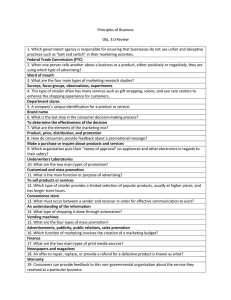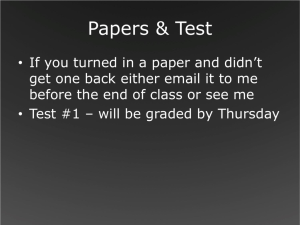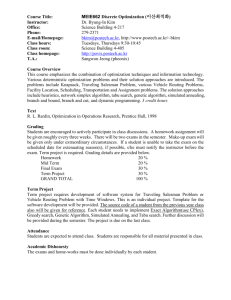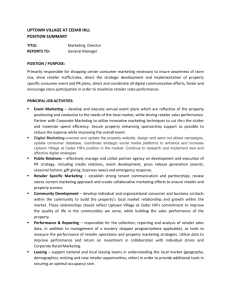Order Quantity Optimization Problem with Limited Budget and Free Return Xingwen Zhang
advertisement
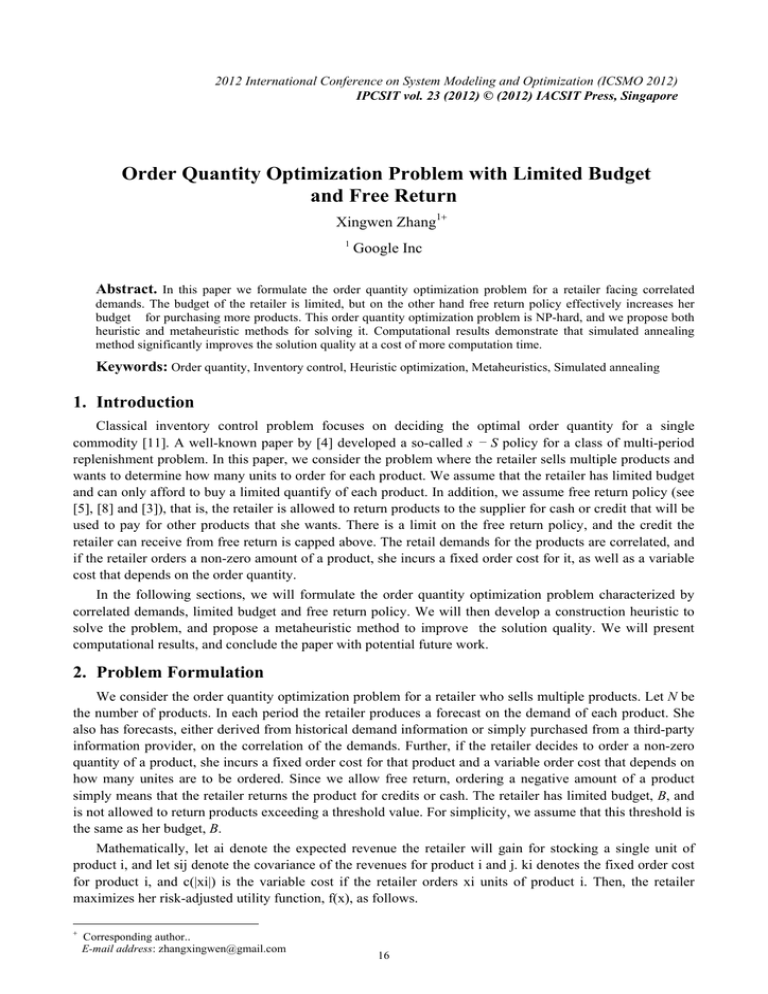
2012 International Conference on System Modeling and Optimization (ICSMO 2012)
IPCSIT vol. 23 (2012) © (2012) IACSIT Press, Singapore
Order Quantity Optimization Problem with Limited Budget
and Free Return
Xingwen Zhang1
1
Google Inc
Abstract. In this paper we formulate the order quantity optimization problem for a retailer facing correlated
demands. The budget of the retailer is limited, but on the other hand free return policy effectively increases her
budget for purchasing more products. This order quantity optimization problem is NP-hard, and we propose both
heuristic and metaheuristic methods for solving it. Computational results demonstrate that simulated annealing
method significantly improves the solution quality at a cost of more computation time.
Keywords: Order quantity, Inventory control, Heuristic optimization, Metaheuristics, Simulated annealing
1. Introduction
Classical inventory control problem focuses on deciding the optimal order quantity for a single
commodity [11]. A well-known paper by [4] developed a so-called s − S policy for a class of multi-period
replenishment problem. In this paper, we consider the problem where the retailer sells multiple products and
wants to determine how many units to order for each product. We assume that the retailer has limited budget
and can only afford to buy a limited quantify of each product. In addition, we assume free return policy (see
[5], [8] and [3]), that is, the retailer is allowed to return products to the supplier for cash or credit that will be
used to pay for other products that she wants. There is a limit on the free return policy, and the credit the
retailer can receive from free return is capped above. The retail demands for the products are correlated, and
if the retailer orders a non-zero amount of a product, she incurs a fixed order cost for it, as well as a variable
cost that depends on the order quantity.
In the following sections, we will formulate the order quantity optimization problem characterized by
correlated demands, limited budget and free return policy. We will then develop a construction heuristic to
solve the problem, and propose a metaheuristic method to improve the solution quality. We will present
computational results, and conclude the paper with potential future work.
2. Problem Formulation
We consider the order quantity optimization problem for a retailer who sells multiple products. Let N be
the number of products. In each period the retailer produces a forecast on the demand of each product. She
also has forecasts, either derived from historical demand information or simply purchased from a third-party
information provider, on the correlation of the demands. Further, if the retailer decides to order a non-zero
quantity of a product, she incurs a fixed order cost for that product and a variable order cost that depends on
how many unites are to be ordered. Since we allow free return, ordering a negative amount of a product
simply means that the retailer returns the product for credits or cash. The retailer has limited budget, B, and
is not allowed to return products exceeding a threshold value. For simplicity, we assume that this threshold is
the same as her budget, B.
Mathematically, let ai denote the expected revenue the retailer will gain for stocking a single unit of
product i, and let sij denote the covariance of the revenues for product i and j. ki denotes the fixed order cost
for product i, and c(|xi|) is the variable cost if the retailer orders xi units of product i. Then, the retailer
maximizes her risk-adjusted utility function, f(x), as follows.
Corresponding author..
E-mail address: zhangxingwen@gmail.com
16
(1)
(2)
(3)
where 1{·} is the indicator function and r is the risk-adjustment coefficient. Constraints (1) and (2)
limit the net amount of order the retailer can place. The problem is clearly NP-hard, since the quadratic
knapsack problem [10] is a special case of the model presented above. To solve the problem, we will first
construct a solution using a hill-climbing based approach. A meta-heuristic approach is then developed to
improve the solution quality.
3 Construction Method
Constructing a good solution for the order quantity optimization with correlated demands is not a simple
task due to the correlation between the demands. For instance, the well-known dynamic programming
approach for knapsack problems [9] does not work here, due to lack of sub-problem optimality (i.e.
Bellman ’ s principle of optimality [2]). Instead, we develop and implement a hill-climbing based
construction method as follows.
To construct a solution of reasonably good quality, we start with the naive solution x = (0; : : : ; 0), that
is, the retailer doesn’t order or return any product. We then iteratively improve the solution quality by
changing xi by δ i, with δ i ∈ {−1; 1}; we call this operator 1-Opt. More specifically, in each iteration we
go through i ∈ {1; : : : ;N} and check whether changing xi to xi + δ i will improve current solution or not. If
it does, we modify current solution by setting xi = xi+ δ i, and repeat the process. We stop until no further
improvement can be made.
To search a larger neighborhood, we also implement a variant of the construction method with 2-Opt that
allows simultaneously changing xi and xj by δ i and δ j respectively, where i ӏ= j and δ i; δ j ∈ {−2;−1; 1;
2}. In each iteration of this construction method, we modify the order quantity of two products aiming to
improve the risk-adjusted utility for the retailer while maintaining the feasibility of the solution. Again, we
repeat the step until there is no further improvement.
4 Simulated Annealing
Simulated annealing (SA) algorithm is used to further improve the solution quality. SA is an extension to
Hill-climbing algorithm. Given a new solution xnew that is better than or equal to the current solution xcurrent,
SA always accepts xnew. In addition, a move that leads to a solution worse than the current solution is
accepted with probability Paccept = e
Δ
, where Δ = f(xnew) − f(xcurrent) is the change in the retailer’s utility
T
function f(x), and T is a control parameter. Simulated annealing algorithm for our order quantity
optimization problem is described in Algorithm 1 (see [6], [7] and [1] for more references on SA).
In our computational experiment, the initial solution is either x = (0; : : : ; 0) or the solution produced by
the construction heuristic, and the initial temperature T is set as 60. The new temperature is calculated by the
formula T′ = λ T, where T is the new temperature and λ = 0:995 is the cooling rate. The stop criterion in
Algorithm 1 is to stop the iterations when xcurrent is not updated in the inner loop. The inner loop criterion is to
perform the loop L times. The value of L is set as 30000.
17
Table 1: Statistics of Solutions by Construction Heuristic and Simulation Annealing with
1- Opt
5 Computational Results
We implemented the construction method and SA algorithm in Java, and tested the methods with 100
randomly generated problem instances with N = 100 products. The results in Table 1 show that with 1-Opt
only SA produces much better solutions than the construction heuristic. The average improvement is about
8.81%, at the cost of more computation time (however, on average the SA method took less than a minute on
a Intel Core2Duo computer with 2 2.26GHz CPUs and 2G RAM). Lastly, when both 1-Opt and 2-Opt were
used the gain of SA decreased to 0.80%, which demonstrated the power of a larger neighborhood move for
the construction heuristic.
6 Conclusions and Future Work
We have formulated the order quantity optimization problem and solved it using construction heuristic
and simulated annealing, and the computational results demonstrated that simulated annealing produced
better results. For future work, we will explore the problems with asymmetric cost between orders and
returns. In addition, other popular metaheuristic methods, such as Tabu Search and Genetic Algorithm, may
produce solutions of better quality. Lastly, neighborhood moves that involve more than two products are
worth exploring as well
7. References
[1] [1] E. Aarts and J. Korst. Simulated Annealing and Boltzmann Machines: A Stochastic Approach to Combinatorial
Optimization and Neural Computing. Wiley, Chichester, 1989.
[2] R. E. Bellman. Dynamic Programming. Princeton University Press, Princeton, NJ, 1957.
[3] L. Chen and H. Lee. Information Sharing and Order Variability Control Under a GeneralizedDemand Model.
Management Science, 55(5):781–797, 2009.
[4] A. Clark and H. Scarf. Optimal Policies for a Multi-Echelon Inventory Problem. Man-agement Science, 6(4):475
–490, 1960.
[5] J. Kahn. Inventories and the Volatility of Production. American Economic Review, 77:667–679, 1987.
[6] S. Kirkpatrick and C. Gelatt amnd M. Vecchi. Optimization by Simulated Annealing. Science, 220(4598):671–
18
680, 1983.
[7] P. J. M. Laarhoven and E. Aarts. Simulated Annealing: Theory and Applications. Reidel, ordrecht, 1987.
[8] H. Lee, V. Padmanabhan, and S. Whang. Information Distortion in a Supply Chain:The Bullwhip Effect.
Management Science, 43(4):546–558, 1997.
[9] S. Martello. Knapsack Problems: Algorithms and Computer Implementations. John Wiley & Sons, Inc., New York,
NY, 1990.
[10] D. Pisinger. The Quadratic Knapsack Problem-a Survey. Discrete Applied Mathematics, 155(5):623–648, 2007.
[11] E. Porteus. Foundations of Stochastic Inventory Theory. Stanford University Press, Stanford, CA, 2002.
19

